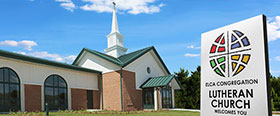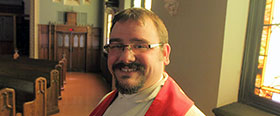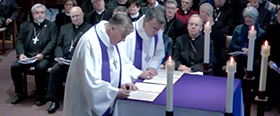In early June a group of young adults from Canada and the United States visited The Lutheran World Federation and the World Council of Churches headquarters in Geneva, Switzerland, and then had a week-long retreat with other international youth at the Taize ecumenical community in southern France. Here is a reflection by one of the participants in “The Plunge.” You can read more about their trip learning about the global church at the complete blog. For more information about next year’s Plunge, which will be May 28 to June 8, please contact the Rev. Amber Ingalsbe at amber.ingalsbe@ststephenmarshall.org.
After a walk in the rain and a quick lunch at the World Council of Churches cafeteria, Plunge participants met with Natasha Klakach, the program executive for church and ecumenical relations with the World Council of Churches. After hearing about the work of The Lutheran World Federation yesterday, Klakach introduced us to the work of the World Council of Churches.
The World Council of Churches is a fellowship of 349 Protestant and Orthodox churches. The organization has a friendly working relationship with the Catholic Church as well. The logo, of a boat with a cross, represents the journey of “the whole inhabited earth” (“Oikoumene”) to come together in fellowship. In a world where there are thousands of Christian denominations, Klakach said that the World Council of Churches seeks “visible unity in one faith and eucharistic fellowship.” After all, “How can we witness in the world if we can’t talk to each other?”
Any churchgoer will know that it’s sometimes hard enough to agree on matters of faith with people in your own congregation, let alone those in other denominations. One of the major challenges to ecumenism is coming to agreement (or “agree to disagree”) on divisive ethical/moral/social justice issues. As church attendance declines in the Global North and rises in the Global South, the demographic shifts are leading to different focuses and approaches for international church organizations and changing the conversation around inter-religious dialogue.
Yet with all of these challenges, there is a lot of hope that comes from ecumenicism. While it may be difficult to come to agreements with multiple denominations, bilateral talks have been effective. For example, the Anglican Church in Canada and the Evangelical Lutheran Church in Canada are in full communion and are jointly hosting national youth gatherings. In an age of declining church attendance, many congregations from different denominations are worshiping together at the local level.
Klakach said that ecumenism “is often spurred by a lack of resources. We have two choices: fear or love?” In choosing fear, we put up walls and try desperately to hold on to what we have, or take from others. By choosing love, we take risks and reach out to others to create something better than what we had before.
— Hannah Shirtliff











